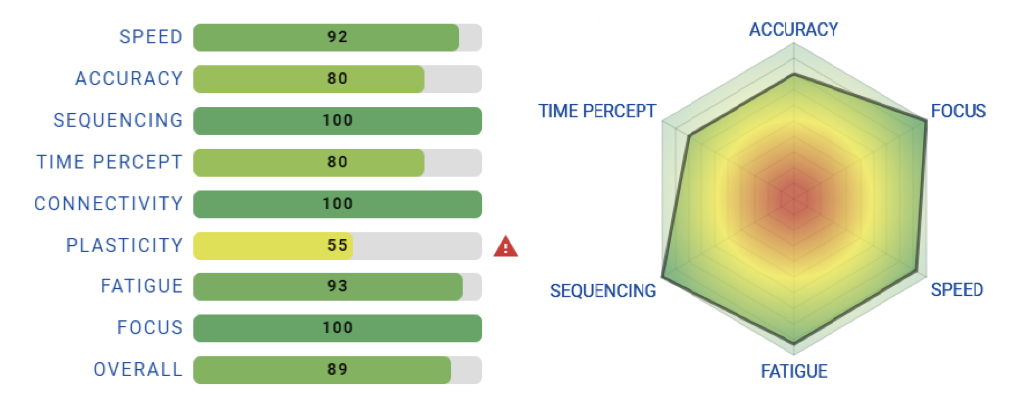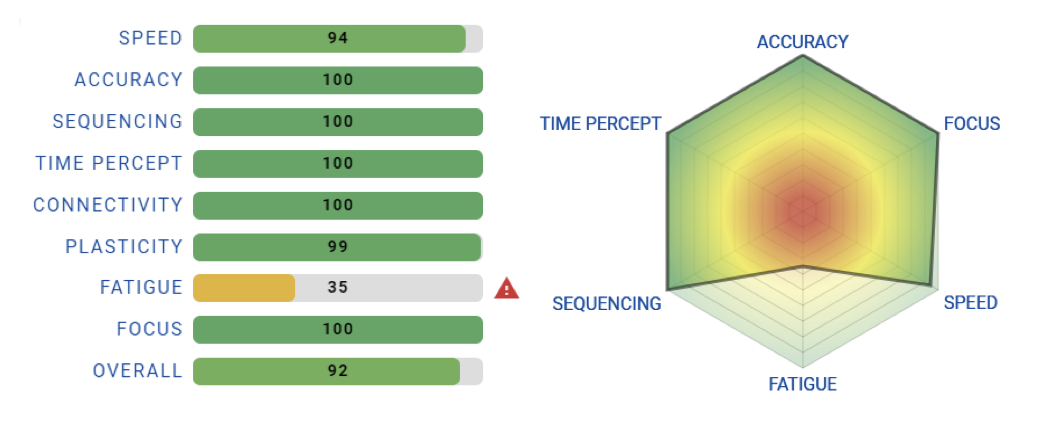Moving from peripheral to systemic pain
12 years ago, fresh into my first semester of college, I blew out a disc in my lower back. Long story short, I wasn’t one of the lucky >90% of people who feel better on their own within a week or two. My pain continued to progress to the point of turning into Reflex Sympathetic Dystrophy Syndrome / Complex Regional Pain Syndrome, which included systemic symptoms such as headaches/migraines, brain fog, extreme fatigue and anxiety, in addition to the intense pain and strange nerve sensations that ran through my leg.
Looking back, it would have been extremely helpful to track what was going on so that I could have stopped the progression to systemic problems before it was too late. But at the time of my injury, the Brain Gauge was far from being available for anyone to purchase, although as the daughter of the inventor, I did have access to the first version—a huge heavy box with results that I couldn’t easily interpret, and the device was way too expensive for my dad to send one back to school with me anyway.
Fast forward 5 years with a compressed nerve and doctor after doctor telling me that surgery wouldn’t help, both my pain and systemic symptoms became unbearable, but the doctors still wouldn’t do anything because I didn’t have any problems that they could see or measure. One doctor went as far as telling me that it was impossible for me to have all the symptoms I was describing. I was in denial that my problems were systemic and not just directly related to a compressed nerve. If I'd had a Brain Gauge, I could have shown the doctors and myself that the problem wasn’t just in my leg anymore. Instead, they put me through almost a year of tests, drugs, and injections that only made things worse before I was finally allowed to have surgery to relieve the pressure off my nerve. While the pain in my leg and back improved, the systemic damage had already been done and the weird nerve sensations and neurological problems continued to progress.
Fast forward a few more years, I finally had a Brain Gauge and access to a way of continuously monitoring changes over time. It was around the time that I was starting a new neurstimulation treatment (InterX) and tracking my results as I went. Not only am I now able to see long term trends to make sure I’m on the right track, but I’m also able to see short term changes to know immediately if the treatment I’m doing is working. Below is an example of the latter.
Examples of how I use my Brain Gauge
I started off one day with a pain flare up and extreme brain fog, and my Brain Gauge results showed problems with plasticity, timing perception, lateral inhibition, and suggested the presence of neuroinflammation. Following treatment that same day, my pain had significantly decreased and my brain felt clearer, but I was exhausted from the treatment. Post-Treatment testing reflected what I felt, while giving a quantitative measure that allowed me to see that systemic changes occurred and I wasn’t just masking pain temporarily. As shown below, all of my metrics improved (besides fatigue, as expected), and I know longer showed evidence of neuroinflammation.
Pre-Treatment; 11AM

Post-Treatment; 4PM

While I have made a lot of progress, I still have my bad days and still use my Brain Gauge to help me figure out what works, what doesn’t work, and when I need to schedule another treatment session. It’s so helpful to have a quantified measure of my brain function and know that I’m not just making things up when I don’t feel good. Neurological symptoms of any chronic condition (fatigue, brain fog, etc) are extremely ambiguous, making them hard for practitioners and patients to quantify and/or believe. Sometimes I wonder myself if I’m just making things up or being lazy on days when I don’t feel good, but a quick test with the Brain Gauge allows me to show myself that I’m not crazy. A recent example is shown below from a day when I was tired but trying to convince myself I was just being lazy and needed to exercise. When I saw my fatigue score, I decided that I really was tired, took some time to rest, and felt a lot better the next day.

Removing stresses from dealing with our current health care system
Having spent a lot of time on the patient side of the health care system, I am very aware of all the problems that come with it - ridiculous costs, long wait times to see doctors, and ambiguous tests. The Brain Gauge helps to solve all of these problems. Without a per-test cost, you can test yourself as often as you’d like. I often put off things like blood tests and medical imaging that might help me figure out when things are wrong because the costs add up so quickly. I love that the Brain Gauge removes the cost roadblock to healing (and with one up-front cost, the more you test, the cheaper it is per test!). The results are immediate — you don’t have to wait weeks to see if you need to make a change, and if you are testing through your doctor, you don’t have to pay for a second follow-up visit to get results back and determine a course of action. Furthermore, the Brain Gauge allows you to test at home and have your doctor see your results, again speeding up the incredibly slow process that is our current health care system.
As stated above, the year before I had surgery was an awful year of doctor appointments, but more than that, it was a year spent waiting for the next appointment. If I hadn't spent so much time waiting for test results and and follow up appointments, I could have avoided a lot of the systemic nerve damage that was progressing during that time.
Another frustration I had with conventional medicine was that no one could ever tell me what was going on and why I felt so bad. With the Brain Gauge, I’m able to see which part(s) of my brain aren’t working optimally and make the appropriate adjustments. When I was in denial about my problems being systemic, my dad kept telling me it was all inflammation. I stubbornly never believed him, so I was resistant to trying new treatments and supplements that could have helped reduce inflammation. As soon as I started using a Brain Gauge, my results indicated the presence of neuroinflammation, so I could no longer deny it. If I had been able to see and track that marker as it developed years earlier, I could have tried treatments, supplements, and lifestyle changes to reduce inflammation, and I could have tracked if it was working—likely preventing the progression of many of my symptoms.
Individualizing recovery from chronic disease
My personal experience and recovery process has forced me to learn a lot about human health and the current epidemic of chronic disease in our society. I’ve also learned that people often get hung up on a diagnosis (I’m guilty of that myself), when really, regardless of the initiating cause, the chronic inflammatory response of your body is the same, although the way individuals respond to a given treatment is often different. The most effective treatments are generally lifestyle changes (such as diet, exercise, supplements, and sleep) and non-conventional treatments (like InterX or PEMF), which may not have a standard treatment protocol or dosage and require some guessing and checking. Without a Brain Gauge, you can subjectively decide if treatment is working, but it might take weeks to months to decide if you think real changes are occurring. With a Brain Gauge, you can objectively measure changes and see much more quickly if your treatment is working (even within the same day, as in my example above). My personal experience taught me that time is extremely important when dealing with chronic disease and the faster you can stop progression and get your body to a state of healing, the easier the healing process will be. Thus, the Brain Gauge is a powerful tool that can allow you to individualize your treatment, track your progress, and even detect and help you reverse a problem before it gets out of control.
